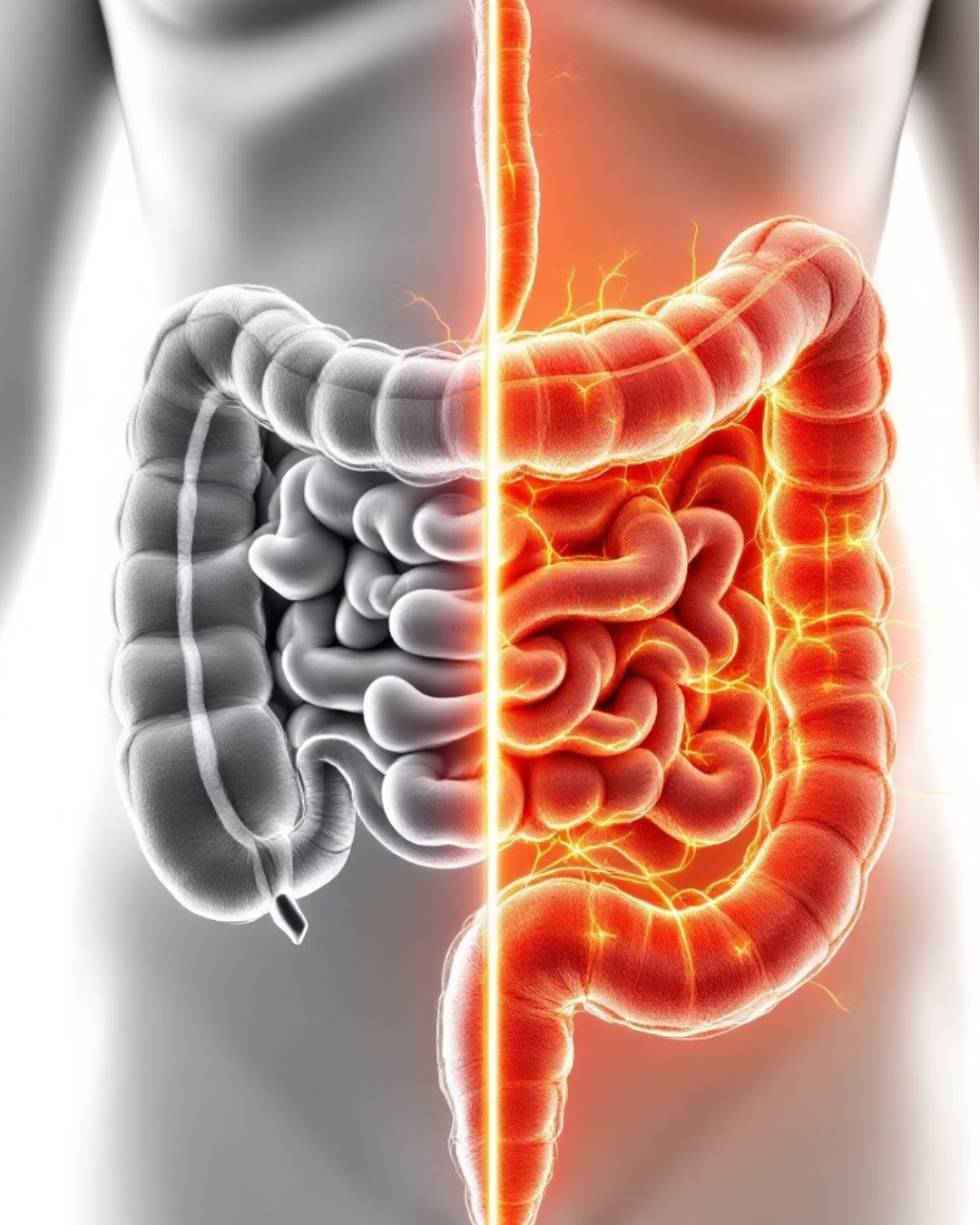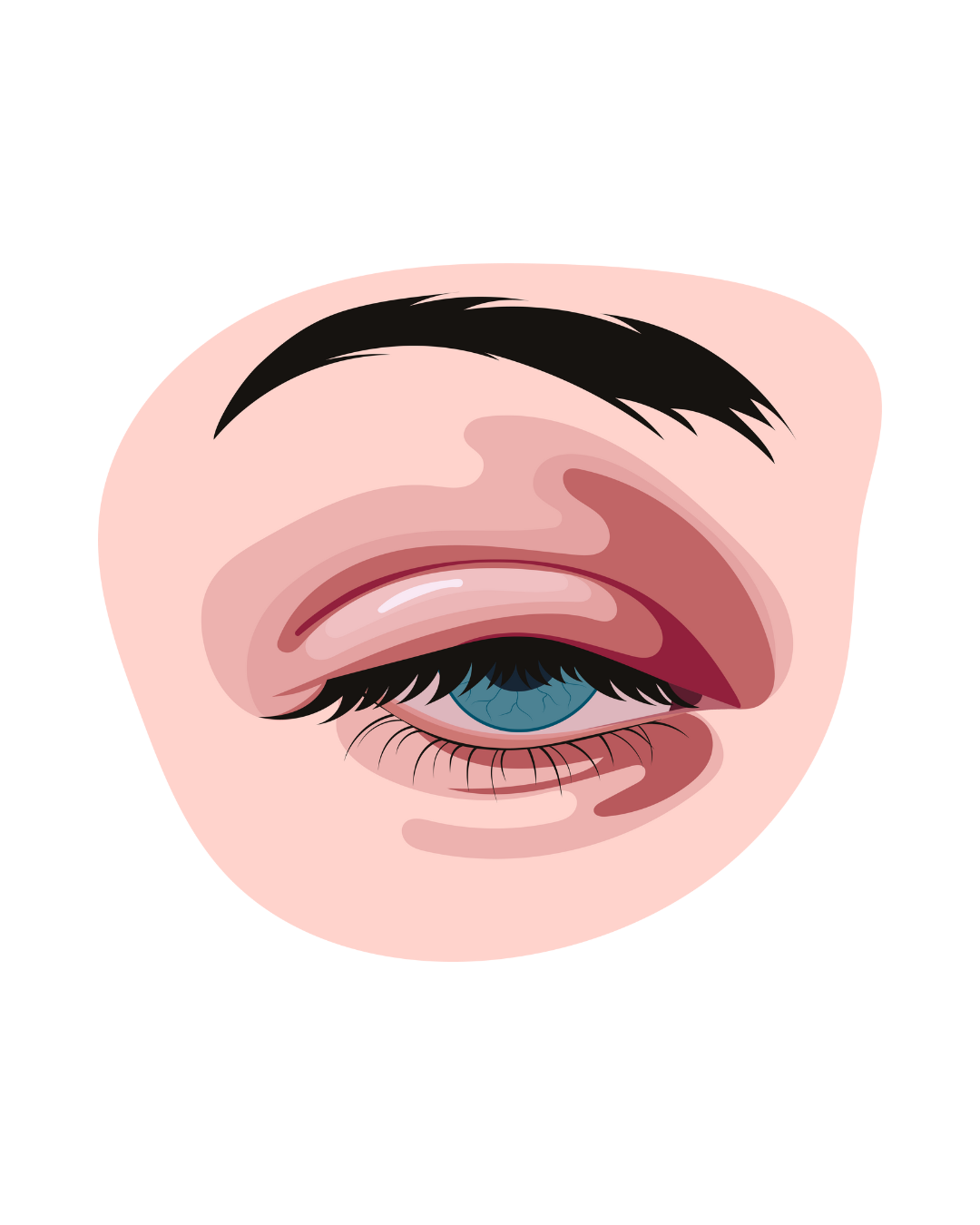
Crohn's & Colitis: Symptoms, Misdiagnoses & Real Root Causes
Most people with IBD spend years searching for answers because the symptoms are confusing, unpredictable, and often brushed off or misdiagnosed. This comprehensive guide explains what's actually happening in your body, in simple terms, while giving you the deeper science if you want it. Think of this page as your "finally, this makes sense" guide to understanding Crohn's disease and ulcerative colitis.
Common Digestive Symptoms of
Crohn's & Colitis
Inflammatory bowel disease (IBD) affects everyone differently, but certain digestive symptoms appear consistently across both Crohn's disease and ulcerative colitis. These symptoms can appear daily or only during flare-ups, making diagnosis challenging and life unpredictable.
The hallmark symptom of IBD is chronic diarrhea, which can occur 10 to 20 times per day or more during severe flares. This isn't ordinary diarrhea 4 it's often accompanied by urgency so intense that it disrupts work, social activities, and sleep. Many people with IBD report feeling chained to the bathroom, unable to travel or leave home comfortably.
Abdominal pain and cramping are equally debilitating. The pain can range from mild discomfort to severe cramping that doubles you over. This pain often signals active inflammation in the intestinal lining, where the immune system is mistakenly eroding healthy tissue.
Abdominal Pain
Cramping, sharp pains, or constant discomfort in the digestive tract
Bloating & Gas
Uncomfortable swelling, gas buildup, nausea, and loss of appetite
Diarrhea & Urgency
Frequent loose stools (sometimes 10-20+ times daily) with sudden, urgent need to use the bathroom
Blood & Mucus
Visible blood or mucus in stool indicating intestinal inflammation
Blood or mucus in the stool is particularly alarming for many people and often the symptom that finally prompts a visit to a gastroenterologist. This visible bleeding occurs because the inflamed intestinal lining becomes fragile and ulcerated. Bloating, gas, nausea, and loss of appetite round out the digestive symptom picture, making eating feel like a minefield where any food might trigger discomfort.
Whole-Body & Systemic Symptoms
One of the most misunderstood aspects of inflammatory bowel disease is that it doesn't just affect your digestive system. Crohn's disease and ulcerative colitis are systemic inflammatory conditions, meaning inflammation can affect virtually every organ system in your body. This is why so many people with IBD feel sick all over, not just in their gut.
Fatigue is perhaps the most common and debilitating whole-body symptom. This isn't ordinary tiredness that improves with rest; it's a profound exhaustion that makes even simple tasks feel overwhelming. The chronic inflammation, nutrient malabsorption, and disrupted sleep that accompany IBD all contribute to this bone-deep fatigue that can feel like burnout.
Arthritis-like symptoms affecting knees, ankles, wrists, and back. This inflammatory arthritis is directly connected to gut inflammation.
Joint Pain & Stiffness
Rashes, irritation, or specific conditions like erythema nodosum and pyoderma gangrenosum that signal immune dysfunction.
Skin Conditions
Uveitis, episcleritis, and other inflammatory eye conditions requiring prompt medical attention to prevent vision problems.
Eye Inflammation
Low grade fevers, chills during flares, and general body aches as the immune system remains chronically activated.
Fever & Body Aches
Painful canker sores and mouth ulcers that mirror the inflammation happening in the intestinal tract.
Mouth Ulcers
Joint pain and stiffness affect up to 30% of people with IBD, causing arthritis-like symptoms in the knees, ankles, wrists, and lower back. Skin rashes and irritation can develop, including specific conditions like erythema nodosum (painful red nodules) and pyoderma gangrenosum (deep ulcerating wounds). Eye inflammation, mouth sores, and fever during flares complete the picture of IBD as a true whole-body disease.
The Gut-Brain Connection: Emotional & Cognitive Symptoms
The connection between your gut and brain is not metaphorical; it's a physical, biological reality mediated by the vagus nerve, immune signalling molecules, and the microbiome itself. This gut- brain axis means that inflammation in your intestines directly affects your brain function, mood, and emotional well-being.
Anxiety is extraordinarily common in IBD, and it's not simply a reaction to having a chronic illness. The inflammatory cytokines produced in your gut travel through your bloodstream and cross the blood-brain barrier, directly triggering anxiety responses. Many people describe feeling anxious even when they can't identify a specific worry or stressor.
Low mood and depression occur at rates two to three times higher in people with IBD compared to the general population. Again, this isn't just about the stress of being sick - it's about inflammatory molecules like IL-6 and TNF-alpha disrupting neurotransmitter production and function in the brain. Brain fog, trouble concentrating, and memory issues plague many people with active IBD. This cognitive dysfunction stems from multiple factors: chronic inflammation affecting brain tissue, nutrient deficiencies (especially B12 and iron), disrupted sleep patterns, and the direct effects of certain medications.
Anxiety
Persistent worry, racing thoughts, and physical anxiety symptoms directly linked to gut inflammation and immune signaling
Low Mood
Depression and emotional flatness caused by inflammatory cytokines disrupting brain neurotransmitters
Brain Fog
Difficulty concentrating, memory problems, and mental fatigue from inflammation and nutrient deficiencies
Low Mood
Insomnia, poor sleep quality, and frequent nighttime bathroom trips that prevent restorative rest
Sleep issues are nearly universal during IBD flares, as nighttime urgency forces frequent bathroom trips, and inflammatory cytokines directly disrupt normal sleep architecture. Poor sleep then worsens inflammation, creating a vicious cycle that's difficult to break without addressing the underlying gut inflammation.
Common Misdiagnoses Before IBD Is Found
The journey to an accurate IBD diagnosis is frustratingly long for most people, averaging 18 to 24months or more, from first symptoms to diagnosis. During this time, many people receive multiple incorrect diagnoses that delay proper treatment and allow the disease to progress unchecked.
Irritable bowel syndrome (IBS) is by far the most common misdiagnosis. While IBS and IBD share some symptoms like diarrhea and abdominal pain, they are fundamentally different conditions. IBS is a functional disorder without visible inflammation, while IBD involves actual tissue damage, ulceration, and immune system dysfunction. Unfortunately, many doctors diagnose IBS without conducting the colonoscopy or imaging needed to rule out IBD.
That said, it’s common for IBS to progress to IBD as the system “wears and tears” over time, leading to progressive breakdown of the gut lining and digestive tissues.
IBS Misdiagnosis
Most common incorrect diagnosis, symptoms overlap but IBS lacks the inflammation and tissue damage of IBD
"Stress-Related Gut Issues”
Symptoms dismissed as purely psychological when physical disease is actually present
Stomach Flu or Infection
Chronic symptoms mistaken for acute bacterial or viral gastroenteritis
Food Sensitivities
Food reactions blamed when underlying inflammation is the true culprit
Lactose Intolerance
Dairy issues assumed to be the sole problem when IBD is driving symptoms
Hemorrhoids
Rectal bleeding attributed to hemorrhoids instead of intestinal ulceration
"Stress-related gut issues" or "nervous stomach" are phrases that make many IBD patients feel dismissed and invalidated. While stress certainly affects gut function, attributing chronic diarrhea, bleeding, and severe pain to stress alone is medical negligence when IBD hasn't been ruled out. Food sensitivities, stomach flu, hemorrhoids, and lactose intolerance are other common misdiagnoses that address symptoms rather than investigating the underlying disease process. These aren't causes; they're symptoms or complications of the real problem beneath the surface.
The REAL Root Causes: Immune Pathway Imbalance
Most IBD cases involve multiple overlapping drivers, not a single cause. Understanding these root causes is essential for effective treatment beyond symptom management. The foundation of inflammatory bowel disease is immune pathway imbalance - specifically, dysregulation of T helper cell responses.
Your immune system has different "lanes" or pathways it can activate, controlled by specialized T cells: TH1, TH2, TH17, and regulatory T cells (Tregs). In healthy individuals, these pathways stay balanced. In Crohn's disease, there's typically an over-activation of TH1 and TH17 pathways, which produce inflammatory cytokines like TNF-alpha, IL-12, IL-17, and IFN-gamma. In ulcerative colitis, there's often a TH2 skew with elevated IL-5 and IL-13.
Regulatory T cells (Tregs) are supposed to act as the immune system's "off switch," calming inflammation and maintaining tolerance to harmless gut bacteria. In IBD, Treg function is impaired, meaning the inflammatory response never properly shuts down. This is why IBD is chronic and relapsing 4 the immune system has lost its ability to self-regulate.
TH1 & TH17 Dominance: Overactive inflammatory pathways producing TNF-alpha, IL-12, IL-17
Treg Dysfunction: Impaired regulatory cells fail to shut down inflammation
Chronic Inflammation: Persistent immune activation causing tissue damage
These immune patterns explain why some people respond to certain medications (like TNF-alpha blockers) while others don't; the specific pathway imbalance varies between individuals. Identifying your dominant immune pathway through specialized testing can help personalize treatment approaches for better outcomes.
Bile Acid Malabsorption & Microbiome Collapse
Bile Acid Dysfunction (BAM): The Overlooked Driver
Bile acid malabsorption is one of the most overlooked causes of IBD symptoms, yet it may drive symptoms in 30-50% of people with Crohn's disease, particularly those with ileal involvement or previous ileal resection. Normally, 95% of bile acids are reabsorbed in the terminal ileum and recycled. When the ileum is inflamed or removed, this reabsorption fails.
The excess bile acids that reach your colon act as a powerful irritant, causing chronic watery diarrhea, burning sensations during bowel movements, urgency, and significant microbiome disruption. This isn't just uncomfortable. It creates a cascade of problems including nutrient malabsorption (especially fat-soluble vitamins A, D, E, K), electrolyte imbalances, and shifts in gut bacteria composition that further perpetuate inflammation.
Ileal Inflammation or Resection
Damage to the terminal ileum prevents bile acid reabsorption
Microbiome Disruption
Altered bile acid pool changes bacterial composition
Excess Bile in Colon
Bile acids irritate colon lining causing diarrhea and inflammation
Nutrient Malabsorption
Fat-soluble vitamins and minerals poorly absorbed
Microbiome Collapse
In both Crohn's disease and ulcerative colitis, the gut microbiome undergoes dramatic shifts. Protective, anti- inflammatory bacteria are lost while harmful, pro-inflammatory species flourish. Specifically, beneficial microbes like Faecalibacterium prausnitzii (which produces the anti-inflammatory short-chain fatty acid butyrate), Bifidobacteria, and Akkermansia muciniphila decline dramatically.
Meanwhile, harmful changes occur: fungal overgrowth (especially Candida species), spikes in proteobacteria (including E. coli strains), and increases in hydrogen sulfide-producing bacteria that damage the intestinal barrier. This dysbiotic state perpetuates inflammation, impairs digestion, reduces short-chain fatty acid production, and leaves the gut with low resilience against triggers and stressors.
SIBO, Fungal Overgrowth & Mold Exposure
Small Intestinal Bacterial Overgrowth (SIBO)
SIBO occurs when bacteria that normally live in the colon migrate upward into the small intestine, where they ferment food and produce excessive gas. Many people with IBD have undiagnosed SIBO driving 30-50% of their daily symptoms, including bloating, gas, abdominal pain, diarrhea, and food intolerances. IBD creates perfect conditions for SIBO: reduced motility from inflammation, strictures that slow transit, alterations in stomach acid and digestive enzymes, and immune dysfunction that fails to control bacterial populations. Treating SIBO in IBD requires a delicate approach, as aggressive antimicrobial therapy can worsen inflammation.
Fungal Overgrowth & Candida
Fungal species,particularlyCandida, thrive in IBD due to low bile flow, frequent antibiotic use, mold exposure, and reduced microbiome diversity. Fungi drive inflammation through specialized immune receptors like Dectin-1, triggering distinct inflammatory pathways that worsen IBD.
Mold & Mycotoxin Exposure
Water-damagedbuildingsrelease mycotoxins that are huge IBD triggers through TLR4 activation
Intestinal Permeability
Mycotoxins directly damage tight junctions causing leaky gut and immune activation
Histamine Overload
Mold triggers mastcellactivation releasing histamine that worsens inflammation
Mitochondrial Damage
Mycotoxins impair cellular energy production causing profound fatigue
Mold and mycotoxin exposure from water-damaged buildings is a significant but often overlooked contributor to IBD flare patterns. Mycotoxins trigger inflammation through TLR4 receptors (the same pathway activated by bacterial endotoxin), causing leaky gut, histamine overload from mast cell activation, mitochondrial injury leading to fatigue, microbiome collapse, bile flow disruption, and major immune dysregulation. Many people notice their IBD symptoms dramatically improve when they move out of a moldy environment or undergo mycotoxin treatment protocols.
Stress, Trauma & Nutrient Deficiencies
Stress & Trauma Physiology
The role of stress in IBD is real, measurable, and profoundly misunderstood. This is not "in yourhead"; it's actually neurobiology. Chronic or unresolved stress, trauma, and adverse childhood experiences directly affect gut function through the autonomic nervous system, particularly the vagus nerve.
When you're in a chronic stress state (sympathetic dominance), your body shuts down non-essential functions including: digestion, bile flow, stomach acid production, and mucosal immunity. Vagal tone (the activity of your vagus nerve that controls the "rest and digest" state) becomes impaired. This creates a physiological environment where IBD symptoms worsen.
Stress also shifts immune function toward pro-inflammatory pathways, increases intestinal permeability, disrupts the microbiome, and impairs the production of protective secretory IgA antibodies. Working with trauma, building stress resilience, and improving vagal tone through specific techniques (breathing exercises, meditation, therapy, bodywork) can significantly reduce IBD flare frequency and severity.
1. Chronic Stress Activation
Sympathetic nervous system dominance suppresses digestive function
2. Vagal Tone Impairment
Reducedrest-and-digestsignaling worsens gut dysfunction
3. Immune Dysregulation
Stress hormones shift immune balance toward inflammation
4. IBD Flare Triggered
Multiple stress-related factors converge to trigger active disease
Critical Nutrient Deficiencies
Certain nutrients are absolutely required for gut repair, immune balance, and inflammatory regulation. These are commonly low in IBD due to malabsorption, increased losses, dietary restrictions, and ongoing inflammation that increases nutrient demands.
Vitamin D Deficiency
Essential for immune regulation andi ntestinal barrier function
Iron Deficiency
Causes profound fatigue and cognitive dysfunction
B12 Deficiency
Critical for nervefunction, energy, and methylation
Zinc Deficiency
Required for tissue repair and immune function
Key deficiencies include zinc (required for tissue repair and immune regulation), vitamin A (critical for mucosal immunity), B12 and folate (necessary for cell division and nerve function), magnesium (needed for over 300 enzymatic reactions), omega-3 fatty acids (powerful anti-inflammatory compounds), glutamine (primary fuel for intestinal cells), and trace minerals like selenium and copper. Comprehensive testing and targeted repletion of these nutrients is essential for IBD recovery.
Why Symptoms Come and Go: Understanding Your Trigger Stack
Oneof the most frustrating aspects of inflammatory bowel disease is the unpredictable nature of flares. You might feel relatively well for weeks or months, then suddenly experience a severe flare seemingly out of nowhere.
Understanding why this happens is key to preventing future flares and achieving lasting remission. IBD symptoms typically flare when several root causes overlap simultaneously: what we call your "trigger stack."
It's rarely just one thing. Instead, imagine each root cause as a potential trigger that can be in an "on" or "off" state at any given time. When multiple triggers are active at once, they create a perfect storm of inflammation.
For example: You might have baseline bile acid dysfunction and microbiome imbalance (always present), but you're managing okay. Then you experience a period of high stress at work (stress physiology activated), get exposed to mold in your office building (mycotoxin trigger), and eat several meals that worsen SIBO (dietary trigger). Suddenly, you have four triggers active simultaneously, and your body can't compensate, and a flare begins.
Stress & Trauma
Bile Dysfunction
Nutrient Deficiency
Mold Exposure
Dysbiosis & SIBO
Diet Triggers
This explains why the same food, stress level, or exposure might cause a flare one month but not the next - it depends on how many other triggers are already active in your system. It also explains why single-intervention approaches (just medication, or just diet, or just stress management) often provide incomplete relief. True healing requires identifying and addressing your specific "trigger stack."
The good news is that once you understand your personal constellation of root causes, you can systematically address them. As you reduce the number of active triggers, your threshold for flares increases dramatically. You build resilience. Foods you couldn't tolerate become safe again. Stressful periods don't automatically mean a flare. This is the path from managing IBD to truly healing from it.
"Understanding your specific 'stack' of triggers is the key to reversing symptoms and achieving lasting remission."
Related Pages:
• Conditions We Treat
• Natural Treatments for IBD
• Lab Testing for IBD
• Mold & IBD
• Work With Josh




























